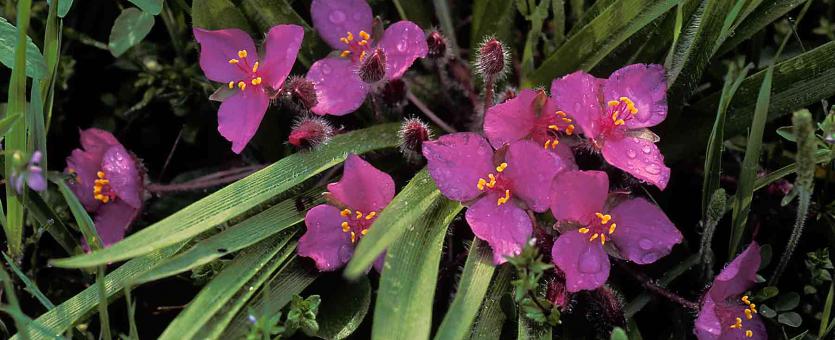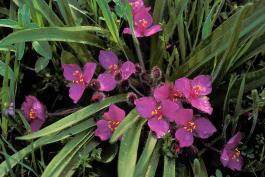
A low-growing, clump-forming perennial. Flowers bright magenta, purple, or purplish blue, in clusters, with the three petals arranged in a triangular pattern; stamens 6, bearded and fluffy. Blooms April–May. Leaves basal, irregularly hairy, grasslike, wide, with a crease along the center vein.
Similar species: There are 8 species of spiderwort in the Missouri flora, plus several documented hybrids that display characteristics of more than one species. This species has been known to hybridize with smooth spiderwort (T. ohioensis). Another species, Virginia spiderwort (T. virginiana), occurs in many of the same areas as dwarf spiderwort. It is only sparsly hairy (if at all) and grows to 16 inches high. It, too, can hybridize with smooth spiderwort.
Height: 6–8 inches.

Scattered, restricted to the eastern half of the Ozark and Ozark Border Divisions. Cultivated statewide.
Habitat and Conservation
Occurs in rocky, mesic upland to dry upland forests in ravines and on ridges; less commonly along the edges of glades and old fields; usually on acidic substrates.
Human Connections
This is an interesting native perennial with showy flowers that can be grown in rock gardens or in other types of gardens. The species name "longipes" ("long-footed") doesn't immediately make sense with such a low-growing species, but apparently it refers to the relatively long leaves.
Ecosystem Connections
Bumblebees and other insects pollinate this plant, and a number of herbivorous mammals, including deer, rabbit, and livestock, eat the foliage. Each flower is open for just one day. Spiderworts are closely related to the common houseplant called "Wandering Jew."























